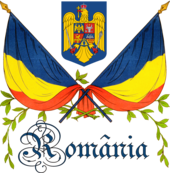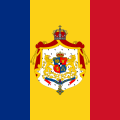User:ES Vic/Zona lego
MY PLAYGROUND!
| This article is part of a series on |
| Symbols of Romania |
|---|
 |
The symbols of Romanian Royalty consist of the five symbols of the supreme authority: the Royal Crown, the mace (the marshal's baton), the Royal Mantle, the Royal Standard ant the Royal Cipher.
History of the symbols
[edit]The Crown, as a symbol pf power, can be found in the Romanian territories since the times of the Romanian rulers (Romanian: Domnitor), as main insignia of the supreme power. The crowns described in different representations, that can be seen in present times (such as paintings, portrayals, sculptures), are not real, this being the reason why the shapes of the crowns of such a wide variety. The crown had the role of symbolizing the sovereignty.[1]
On the paintings made with the occasions of the numerous foundations, on some coins or tomb stones, the Wallachian and Moldavian Domnitori (Rulers) are represented (almost always) wearing a golden crown. This crown is usually an open princiary crown , formed by three or five ornaments shaped as flowers or leaves (Romanian: fleuroane). in the XIV and XV centuries, the crowns of the Romanian Domnitor are similar to the heraldric crowns, in the latter centuries becoming bigger and more decorated. In the Phanariote period, the Phanariotes are rarely represented with a crown on the head, being sculpted or portrayed at the "crowning ceremony" (Romanian: ceremonia înscăunării - meaning the ceremonial of sitting on the Throne) with the Janissary headgear or with a special hat, of Turkish origin (Turkish: işlic; Romanian: işlic) at other solemn occasions. In the XIX century representations the crown is layed on a pillow or table in the proximity of the ruler's image.
Other signs of power are the mace and the sword. This symbols can be found on the coins, seals, coat of arms and standards of that time. The mace and the sword or shamshir where the main princiary symbols until Alexandru Ioan Cuza. in some cases the Rulers are depicted with other symbols, different than the mace and sword. Dimitrie Cantemir is one of them, being depicted with a short baton, similar to the Marshal's baton.
The first representation of a Romanian Domnitor with the symbols of authority appears on the coins of Mircea the Elder. He was represented wearing an open princiary crown, and dressed with a mantle (long up to the ankles) with ermine collar. In the right hand the Domnitor had a mace (sometimes a sword), and in the left hand a globus cruciger. The Rulers that followed him, both Wallachians and Moldavians, wore a similar mantle, called in Romanian: caftan. The Phanariotes wore a mantle called in Romanian: cabaniţa ienicerilor. The Romanian Rulers from the XIX century reintroduce the mantle as symbol of authority, but unlike the Mircea the Elder's ceremonial dress, these had a long tail.
The cyphers used by the Domnitori where formed by their initials. The signs where printed on small seals and on other objects. After 1834, the cyphers appear mostly on the flags (the battle/war flags)[2].
Coroana regală
[edit]
The royal crown is the most important symbol of Romanian Royalty. That's why there was a special attention for the manufacturing process of the crown.
The Steel Crown of King Carol I of Romania was forged at the Army Arsenal (Romanian: Arsenalul Armatei) in Bucharest of the steel of a gun captured by the Romanian Army from the Ottomans during the War of Independence (1877-1878). Carol I chose steel, and not gold, to symbolize the bravery of the Romanian soldiers. He received it during the ceremonies of his coronation and of the proclamation of Romania as a kingdom in 1881. It is the same Crown used in 1922 at the coronation of King Ferdinand I and Queen Maria as sovereigns of Romania, which took place in Alba-Iulia. The Crown was used also during the coronation[3] and anointment as King of Michael I of Romania by the Orthodox Patriarch of Romania, Nicodim Munteanu, in the Patriarchal Cathedral of Bucharest, on the very day of his second accession, September 6, 1940.[4]
The Crown of Queen Elisabeta was forged at the Army Arsenal (Romanian: Arsenalul Armatei) as well, being made of gold. It has the same decorations as the King's Crown; it too was made after the War of Independence (1877-1878). The swape of the crown is inspired by the Romanian Orthodox iconography, resembling the crowns worn by the Romanian Ruler's wives, Wallachians or Moldavians, during the Middle Ages, thus expressing the historical continuity. Queen Elisabeta wore it for the first time on the occasion of the coronation ceremony that took place in Bucharest on 10/22 May 1881, the day when Romania became a Kingdom.
The crown, respecting the heraldic norms, has a frontal steel circle, orned with rectangular and diamond-shaped stones, and pearls made of the same material. In the superior part of the circle there are applied eight large ornaments, in the form of leaves (Romanian: fleuroane), alternated by eight smaller shapes, having in the upper part pearls.
Coroana regală, respectând normele heraldice, are în compunere un cerc frontal de oţel, ornamentat cu pietre alungite, rombice şi perle şlefuite din acelaşi material. În partea superioară a cercului au fost aplicate 8 ornamente mari, sculptate în formă de frunză (fleuroane), alternate prin 8 figuri mai mici având în partea superioară perle. De vârfurile fleuroanelor au fost ataşate 8 tije arcuite înguste, împodobite cu mărgăritare, care se unesc într-un glob în care a fost implantată crucea „Trecerii Dunării”. Toate elementele coroanei sunt din oţel; partea interioară (căptuşeala) este confecţionată din catifea purpurie.
Are la bază un cerc lat din aur, ornamentat în partea inferioară cu un rând de boabe de grâu în relief. În registrul de deasupra se află un decor vegetal răsucit având câte un turcoaz alternând cu două smaralde caboşon. Din acest decor se desprind arcuiţi spre exterior opt fleuroni dintre care patru mari şi patru mijlocii alternând cu alţi opt fleuroni mici treflaţi, dispuşi la înălţimi diferite. Astfel, cei opt fleuroni mici, plasaţi la înălţime mai mică au câte trei petale rotunde şi egale, având fiecare petală câte un opal caboşon şi un ametist romboidal la bază. Mai sus sunt patru fleuroni cu câte trei petale uşor alungite, decorate cu trei opale caboşon, dintre care cel din mijloc este mai mare. Aceşti fleuroni alternează cu alţi patru uşor mai înalţi, având câte un rubin caboşon în petala centrală, câte un opal în celelalte două petale, iar la bază câte un turcoaz mare, oval, caboşon. Din spatele fleuronilor pleacă opt braţe late, din aur, decorate cu motive vegetale alternând cu motive geometrice uşor supraînălţate la partea anterioară şi coborâte spre centru. În punctul în care se unesc se află un glob suprapus de o cruce gamată, ambele din aur. Lateral, de o parte şi de alta a cercului de bază, în dreptul urechilor este prins prin două verigi din aur, câte un pandantiv circular. Pandantivul este compus dintr-o ramă din aur în care se înscrie un romb încadrat de motive vegetale traforate pe care sunt aplicate patru opale şi opt smaralde caboşon. Pe unul din romburi este reliefată în aur stema României, pe celălalt stema Casei de Edinburgh. De pandantiv sunt prinse cu câte un mic anou trei lănţişoare din aur cu verigile în formă de boabe de grâu. Lănţişoarele se prind de anouri cu câte un opal caboşon în montură circulară. Alte trei opale sunt montate la mijlocul fiecărui lanţ. La capetele lanţurilor se află câte o cruce gamată din aur înscrisă într-un cerc. Lanţul din mijloc este mai lung. Coroana are în interior o căptuşeală din catifea roşie. A fost purtată la Încoronarea de la Alba Iulia din 15 octombrie 1922 de către regina Maria. Desenul coroanei a fost realizat de pictorul Curţii regale Costin Petrescu.
Coroana purtată de regina Maria la încoronarea de pe 15 octombrie 1922 de la Alba Iulia apare pe piesele de 25 şi de 50 de lei ale acestui set. Coroana a fost executată la Paris, de casa de bijuterii "Falize", după desenele pictorului Costin Petrescu. Acesta a folosit ca sursă de inspiraţie coroana purtată de Doamna Elena - Despina (soţia lui Neagoe Basarab, domnitor al Ţării Româneşti între 1512 şi 1521, fiica despotului sîrb Iovan Brancovici), aşa cum apare ea zugrăvită în tabloul votiv al bisericii episcopale de la Curtea de Argeş.
Braţele coroanei sînt evazate, fiind terminate în vîrfuri cu crini. Coroana este bătută cu pietre scumpe. Pe laterale are cîte un pandantiv, cu cîte un disc de care atîrnă cîte trei şiruri de mărgele, terminate cu cîte un o cruce gamată. Pe cele două discuri sînt reprezentate stema României şi a Marii Britanii (aceasta din urmă ca un omagiu adus originii britanice a reginei Maria). În vîrful coroanei se găseşte o cruce gamată. Din punct de vedere artistic, coroana aparţine aşa-zisului "stil 1900".
Coroana are aproape 2 kg, cu diametrul la bază de 17.5 centimetri şi cu înălţimea de 18 centimetri. Actualmente se găseşte expusă în sala Tezaur a Muzeului Naţional de Istorie, la Bucureşti.
-
The king's crown (1881)
-
Crown of Queen Elisabeta (1881)
-
Crown of Queen Maria (1922)
Buzduganul
[edit]Buzduganul ca simbol al puterii regale a fost adoptat de regele Ferdinand I, sceptrul nefiind utilizat în România. [5]. În mod simbolic, buzduganul i-a fost oferit lui Ferdinand I de către poporul român în 10 mai 1920. Pe acest buzdugan, în partea superioară, sunt reprezentate patru statuete de ţărănci în costume naţionale. Ele reprezintă România (regatul vechi), Transilvania, Basarabia şi Bucovina. În vârful buzduganului se regăseşte capul acvilei cruciate.
Carol I şi Carol II au folosit ca simbol al puterii bastonul de mareşal în locul buzduganului. Bastonul purtat de aceştia are formă cilindrică cu secţiunea rotundă şi cu o lungime de 35 cm. Este acoperit cu o catifea purpurie pe care sunt imprimate capete de bour, confecţionate din aur, iar la extremităţi este ornamentat cu frunze de stejar, realizate din aur.
Mantia regală
[edit]În România, mantia a fost folosită pentru prima dată la încoronare de către Ferdinand I, Carol I fiind încoronat în uniformă de general. Mantia regală folosită de Ferdinand I era dintr-o ţesătură de mătase roşie ornamentată cu fir de aur (brocat), cu un guler de hermină şi îi ajungea acestuia până la glezne.
Pavilionul regal
[edit]-
Royal standard of the King (1930)
-
Royal standard of the Queen (1922)
-
Royal standard of the Crown Prince (1922)
-
Royal standard of the Queen Mother (1941)
-
Royal standard of the other members of the Royal Family (1922)
-
Royal standard of the King (1881)
-
Royal standard of the Crown Prince (1881)
Cifra regală
[edit]Cifra regală, folosită pentru însemnarea obiectelor care parţineau regelui şi casei regale, aplicată pe scrisorile şi cărţile acestuia, sau ca semn distinctiv pe drapele şi uniforme, era formată din iniţiala numelui regelui. Cifrele regilor Carol I şi Carol II erau formate din doi C adosaţi şi intercalaţi File:Cifra Carl I.svg. Ferdinand folosea ca cifră un semn format doi F andosaţi File:Cifra Ferdinand.svg. De obicei cifrele regale prezentau în partea superioară a simbolului şi o coroană.
Note
[edit]- ^ Enciclopedia României (1938-1943), pg. 83
- ^ Mihail Sturdza had an M, Alexandru Ghica an A, Barbu Ştirbei a B, Alexandru Ioan Cuza an A superimposed iver an I (see the coat of arms proposal from 1863)
- ^ Fundamental Rules of the Royal Family of Romania, The Romanian Royal Family website as retrieved on January 8, 2008
- ^ (in Romanian) "The Joys of Suffering," Volume 2, "Dialogue with a few intellectuals", by Rev. Fr. Dimitrie Bejan - "Orthodox Advices" website as of January 21, 2008
- ^ *Enciclopedia României (1938-1943), pg. 83
Bibliografie
[edit]- Enciclopedia României. Comitetul de direcţie: D. Gusti, Constantin Orghidan, Mircea Vulcanescu si Virgiliu Leonte. Imprimeria Naţională. Bucureşti 1938-1943








